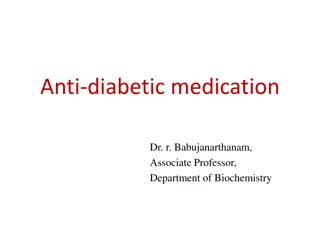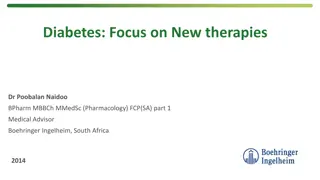Understanding the Impact of Diabetes on Vision
Diabetes can have a significant impact on eye health, leading to conditions like retinopathy, glaucoma, cataract, and changes in refractive errors. Nearly 5% of Australians have diabetes, with a high risk of developing related eye problems. Recognizing early signs such as blurred or fluctuating vision is crucial, and regular monitoring by an optometrist is recommended to detect diabetes-related eye issues promptly.
Download Presentation

Please find below an Image/Link to download the presentation.
The content on the website is provided AS IS for your information and personal use only. It may not be sold, licensed, or shared on other websites without obtaining consent from the author. Download presentation by click this link. If you encounter any issues during the download, it is possible that the publisher has removed the file from their server.
E N D
Presentation Transcript
Contents Diabetes facts Changes to the eyes with diabetes Diabetic retinopathy Background retinopathy Proliferative retinopathy Diabetes and glaucoma Diabetes and cataract Diabetes and refractive errors
Diabetes facts Nearly 5% of Australians have diabetes More than 70% of people with diabetes will develop diabetes related eye problems within 15 years of diagnosis
Changes to the eyes with diabetes Blurred vision Fluctuating vision Can occur early on in the disease An optometrist will often be the first person to pick up that someone has diabetes
Changes to the eyes with diabetes Changes to retinal blood vessels (retinopathy) Increased likelihood of Cataract Glaucoma Changes to refractive error
Normal retina Retinal blood vessels Optic nerve Macula
Diabetic retinopathy 1. Background retinopathy rarely causes loss of vision. You still see well . no treatment required need to monitor regularly
Diabetic retinopathy 2. Proliferative retinopathy more serious requires early treatment significant loss of vision can occur
Diabetic retinopathy risk depends on: Length of time you have had diabetes How well your blood sugar level is controlled
Glaucoma Disease of the optic nerve Affects peripheral vision first Difficult to detect in the early stages Slightly more common if you are diabetic
Cataract Clouding of lens inside eye Gradual loss of vision Increased awareness of glare Occurs at an earlier age if you are diabetic
Refractive errors Myopia Short-sightedness Hyperopia Long-sightedness Astigmatism Corneal irregularity Presbyopia Loss of close vision with age
Regular eye tests are vital if you have diabetes Every 12 months OR more often if you have some form of retinopathy No referral is required Diabetic examinations attract a Medicare rebate Find your local optometrist here: www.optometry.org.au/find-an-optometrist/
Optometrists Provide a thorough vision and eye health exam Detect and diagnose eye health problems Prescribe and supply glasses and contact lenses when required Diagnose and treat eye coordination and focusing problems
Read more about Diabetes & Eyes www.goodvisionforlife.com.au/vision-problems/diabetic-retinopathy/

















































